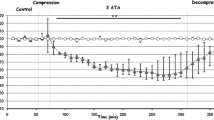Abstract
Inert gas narcosis is a neurological syndrome inducing several psychomotor disorders. Nitrogen narcosis represents the major cause of performances decrease concerning divers, in the depth range of 30 to 90 meters (0.3 to 0.9 MegaPascal). As narcosis affects motor functions, we chose to study the nigro-striatal dopaminergic pathway owing to its involvement in psychomotor disorders. The aim of this study is to compare, in the Sprague-Dawley rats striatium, changes in extracellular concentrations of Dopamine and its metabolites: Dihydroxyphenylacetic Acid (DOPAC) and Homovanillic Acid (HVA) under a normobaric narcosis (20; 40, and 60% of Nitrous Oxide (N2O)) on one hand, and under 0.9 MegaPascal of Nitrox (Nitrogen Oxygen normoxic mixture) on the other hand. In fact, if these two conditions are similar, normobaric narcosis would allow us to explain nitrogen narcosis mechanisms without any pressure effect. The first emergence of Dopamine and metabolites variations occurs around 40% of N2O. Dopamine decreases by 45% and is accompanied by a DOPAC diminution of 7% while HVA concentrations remain constant. Under 60% N2O, these decrease have a greater amplitude. The Dopamine variations obtained under 0.9 Mpa of Nitrox are closed to alterations induced by 60% of N2O (DA decreases by 70%).
Similar content being viewed by others
REFERENCES
Behnke, A. R., Thomson, R. M., and Motley, E. P. 1935. The psychologic effects from breathing air at 4 atm. pressure. Am. J. Physiol. 554:558–112.
Brauer, R. W., and Way, R. O. 1969. Relative narcotic potencies of hydrogen, helium and nitrogen and their mixtures. J. Appl. Physiol. 123:131–29.
Miller, K. W. 1977. The opposing physiological effects of high pressure and inert gases. Fed. Proc. 1663:1667–36.
Risso, J. J., Saget, A., Toumaniantz, G., and Barthelemy, M. 1994. Involvement of dopaminergic pathways in narcosis and HPNS. A field of application for microdialysis. Pages 146–147, in Louilot, A.; Ourkin, T., Spampineto, U. and Cador, M. (eds), Monitoring Molecules in Neuroscience.
Barthelemy-Requin, M., Semelin, P., and Risso, J. J. 1994. Effect of nitrogen narcosis on extracellular levels of dopamine and its metabolites in the rat striatum, using intracerebral microdialysis. Brain. Res. 1:5–667.
Saget, A., Toumaniantz, G., Huppe, J. M., and Risso, J. J. 1994. In vivo binding experiment using microdialysis: a study of normobaric narcosis under nitrous oxide. Pages 148–149, in Louilot and colleagues (eds). Monitoring Molecules in Neurosciences.
Fowler, B., Pang, E., and Mittchel, J. 1992. On controlling inert gas narcosis. Human Factors. 115:120–34.
Jennings, R. D. 1973. Nitrogen narcosis and rat behavior on Fixed-Ratio and Differential Reinforcement of low-rate schedules. J. Comp. Physiol. Psychology. 515:522–83.
Hynes, D. M., and Berkowitz, B. A. 1983. Catecholamine mechanisms in the stimulation of mouse locomotor activity by nitrous oxide and morphine. Eur. J. Pharmacol. 109:114–90.
Czech, D. A., and Quock, R. M. 1993. Nitrous oxide induces an anxiolytic-like effect in the conditioned defensive burying paradigm which can be reversed with a benzodiazepine receptor blocker. Psychopharmacol. 211:216–113.
Tanzarella, S., Courtiere, A., and Hardouin, J. 1996. Effets du protoxyde d'azote sur l'activité locomotrice chez le rat Long-Evans: Etudes comportementales et pharmacologiques. Trav. Scient. SSA. 141:142–17.
Courtiere, A., and Hardouin, J. 1997. Behavioral effects induced by nitrous oxide in the rat performing a vigilance task. Physiol. Behav. 408:415–8.
Caton, P. W., Tousman, S. A., and Quock, R. M. 1994. Involvement of nitric oxide in nitrous oxide anxiolysis in the elevated plus-maze. Pharmacol. Biochem. Behav. 689:692–48.
Ostlund, A., Linnarson, D., Lind, F., and Sporrong, A. 1994. Relative narcotic potency and mode of action of sulfure hexafluoride and nitrogen in humans. Am. Physiol. Soc.
Edmonds, C., Lawry, C., and Pennefather, J. 1981. Nitrogen narcosis. Pages 197–208, in Diving Medical Center publication, 2nd edition. Sydney, Australia.
Mastrangelo, C. J., Kendig, J. J., Trudell, J. R., and Cohen, E. N. 1979. Nerve membrane fluidity: opposing effects of high pressures and ethanol. Undersea. Biomed. Res. 47:53–6.
Abraini, J. H., and Rostain, J. C. 1991. Pressure-induced striatal dopamine release correlates hyperlocomotor activity in rats exposed to high pressure. J. Appl. Physiol. 638:643–71.
Fechtali, T., Abraini, J. H., Kriem, B., and Rostain, J. C. 1994. Pressure increases de novo synthesized striatal dopamine release in free-moving rats. NeuroReport. 725:728–5.
Mac Leod, M., Bennett, P. B., and Cooper, R. L. 1988. Rat brain catecholamine release at 1, 10, 20, and 100 ATA Heliox, Nitrox and Trimix. Undersea. Biomed. Res. 211:221–15.
Requin, M., and Risso, J. J. 1992. Effects of high pressure on striatal dopamine release in freely moving rats: a microdialysis study. Neuroscience Letters. 211:214–146.
Leviel, V., Gobert, A., and Guibert, B. 1989. Direct observation of dopamine compartmentation in striatal nerve terminal by «in vivo» measurement of the specific activity of released dopamine. Brain. Res. 205:213–499.
Abraini, J. H. 1997. Inert gas and raised pressure: evidence that motor decrements are due to pressure per se and cognitive decrements due to narcotic action. Pflugers Arch. 788:791–433.
Author information
Authors and Affiliations
Rights and permissions
About this article
Cite this article
Turle, N., Saget, A., Zouani, B. et al. Neurochemical Studies of Narcosis: A Comparison Between the Effects of Nitrous Oxide and Hyperbaric Nitrogen on the Dopaminergic Nigro-Striatal Pathway. Neurochem Res 23, 997–1003 (1998). https://doi.org/10.1023/A:1021040607207
Issue Date:
DOI: https://doi.org/10.1023/A:1021040607207




